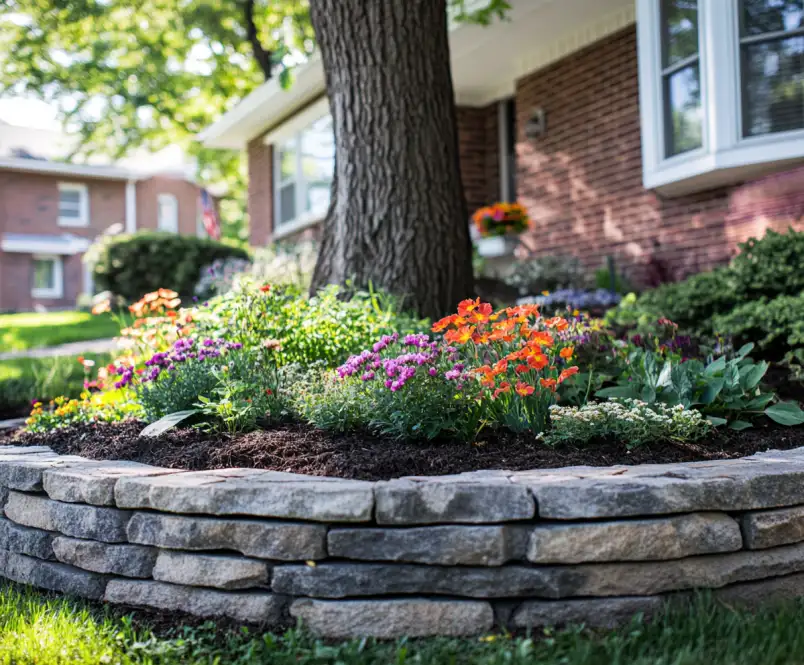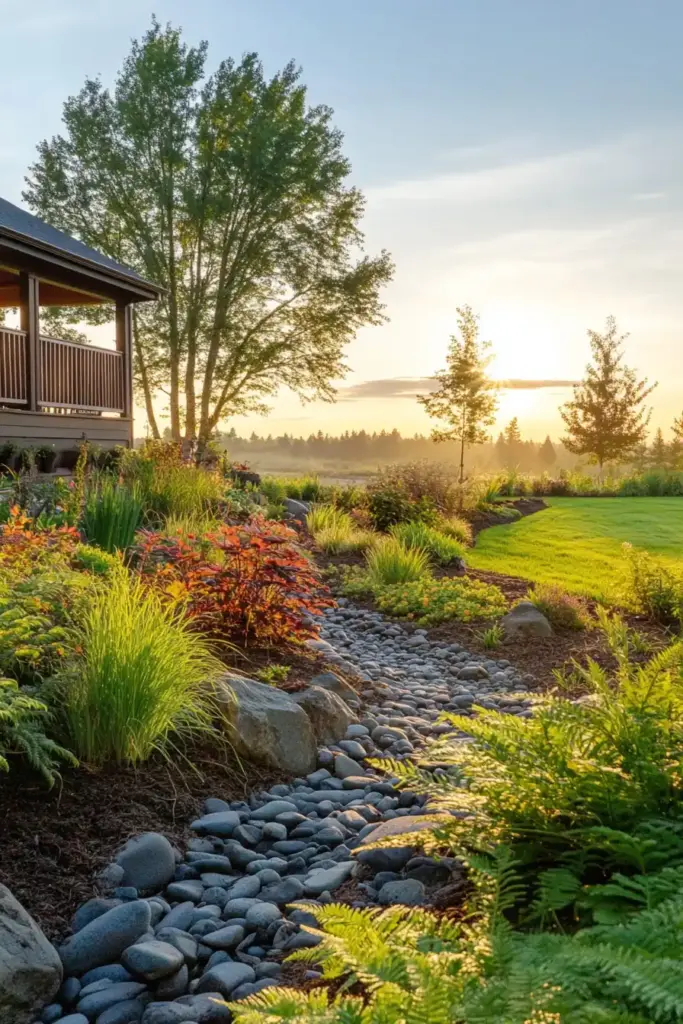Landscaping around trees is a smart way to transform a dull, shaded spot into a vibrant garden focal point. Whether you’re working with a majestic oak or a newly planted fruit tree, the space beneath the canopy can become a lush, inviting haven with thoughtful planning. If you’re also considering privacy trees along a fence, blending strategic landscaping with evergreen screens not only boosts curb appeal but also creates a cohesive and serene backdrop.
There are a few essentials to keep in mind—tree roots need protection, shaded zones can limit plant variety, and managing moisture is key. But with the right guidance, you can create functional, low-maintenance spaces that feel intentional and polished. For more inspiration, check out our guide to backyard privacy screen ideas and discover how landscaping can double as a privacy solution.
In this article, we’ll walk through 15 creative ways to landscape around trees—including mulched beds, rock gardens, and fairy garden bases—all designed to help you turn tricky spots into beautiful, garden-worthy features.
Table of Contents
1. Rock Garden Oasis
If grass refuses to grow under your trees, a rock garden is a fantastic solution—especially when you’re aiming for a low-maintenance yet high-impact design. This approach is not only practical but also complements adjacent privacy trees along fences, creating a seamless and naturalistic backyard environment.
Start by clearing the area around the tree and laying down a mix of river rocks, gravel, and larger boulders. Use irregular patterns to mimic nature and soften the look. Incorporate drought-tolerant, shade-loving plants like hostas, ferns, and coral bells between the stones for a lush, layered effect.
This type of landscaping not only minimizes weed growth and erosion but also highlights the tree as a central garden feature. It’s especially effective beneath mature oaks or evergreens, where sunlight is scarce and roots are shallow.
Pro Tip: Rock gardens pair beautifully with a row of privacy trees along a fence—such as arborvitae or leyland cypress—providing structure, texture, and year-round greenery behind your tree-focused design.
2. Raised Stone Borders
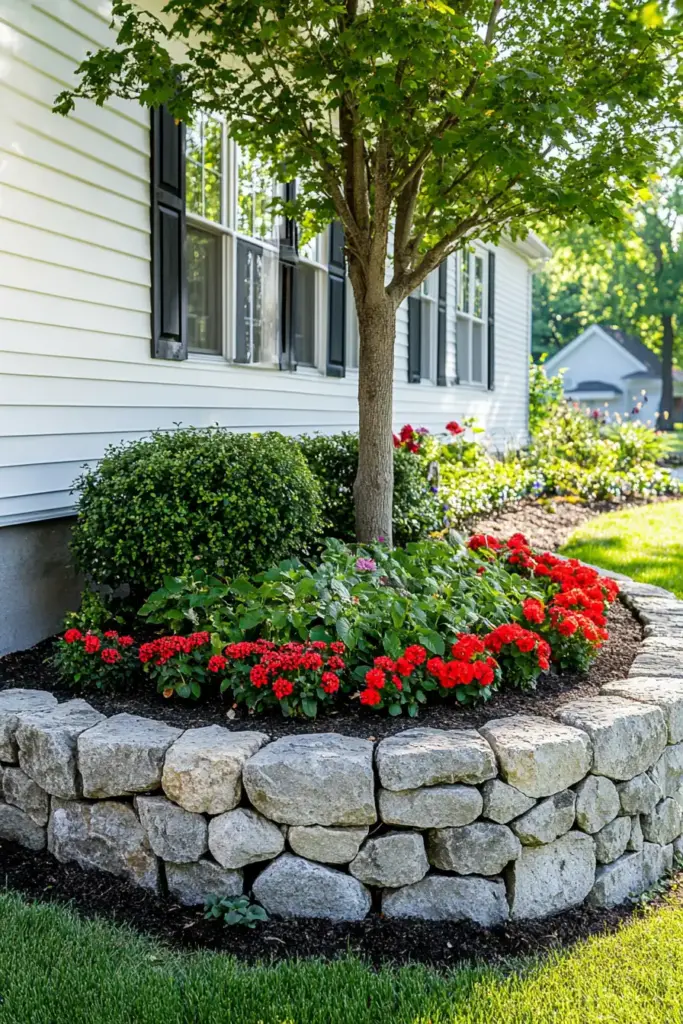
If you’re looking for a clean, structured way to landscape around trees, raised stone borders offer a polished solution. They define the tree’s base beautifully and prevent mulch or soil from spilling into the surrounding lawn. Plus, when paired with privacy trees along a fence, they help visually frame your entire garden layout.
To create this look, stack flat stones, bricks, or interlocking concrete blocks in a circular or semi-circular shape around the tree. Aim for a height of 6–12 inches to maintain a natural appearance without suffocating the roots. Inside the border, fill the area with rich soil and add a layer of mulch or shade-friendly plants like impatiens, begonias, or caladiums.
This method not only keeps everything tidy but also protects the tree’s root zone from foot traffic and erosion.
Bonus Tip: Installing raised borders near a row of privacy trees along the fence creates garden “zones” and draws the eye naturally from the tree inward toward lush greenery.
3. Mulch Beds
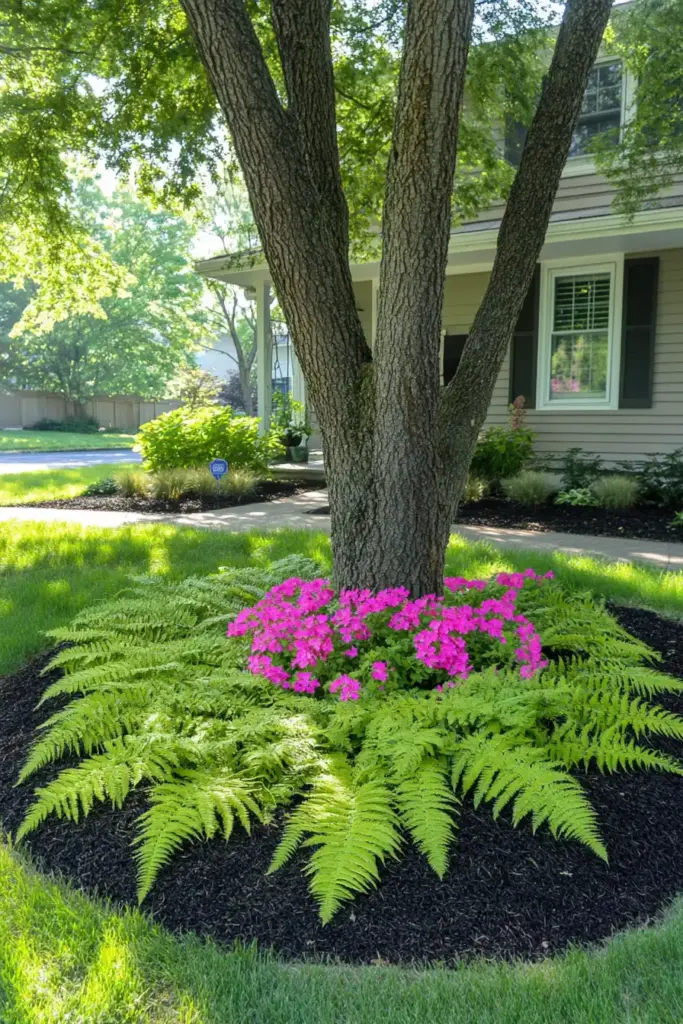
Sometimes, simplicity is the most effective strategy. Mulch beds are a classic and low-maintenance way to landscape around trees, especially if you’re working with young or newly planted specimens. When combined with privacy trees along the fence, they create a cohesive, calming backdrop that ties your garden together.
To start, clear any existing grass or weeds from around the base of the tree, then apply a generous layer of organic mulch—bark, shredded wood, or pine needles are all great options. Aim for a 2–4 inch depth, and always leave a few inches of space between the mulch and the trunk to prevent rot and pests.
Mulch beds improve moisture retention, suppress weeds, and insulate tree roots from extreme temperatures. They’re also incredibly adaptable—ideal for any size of yard and any tree type.
Garden Insight: Mulch beds are a seamless design element between large shade trees and a backdrop of privacy trees along the fence, offering a unified and tidy aesthetic across your outdoor space.
4. Gravel Landscaping
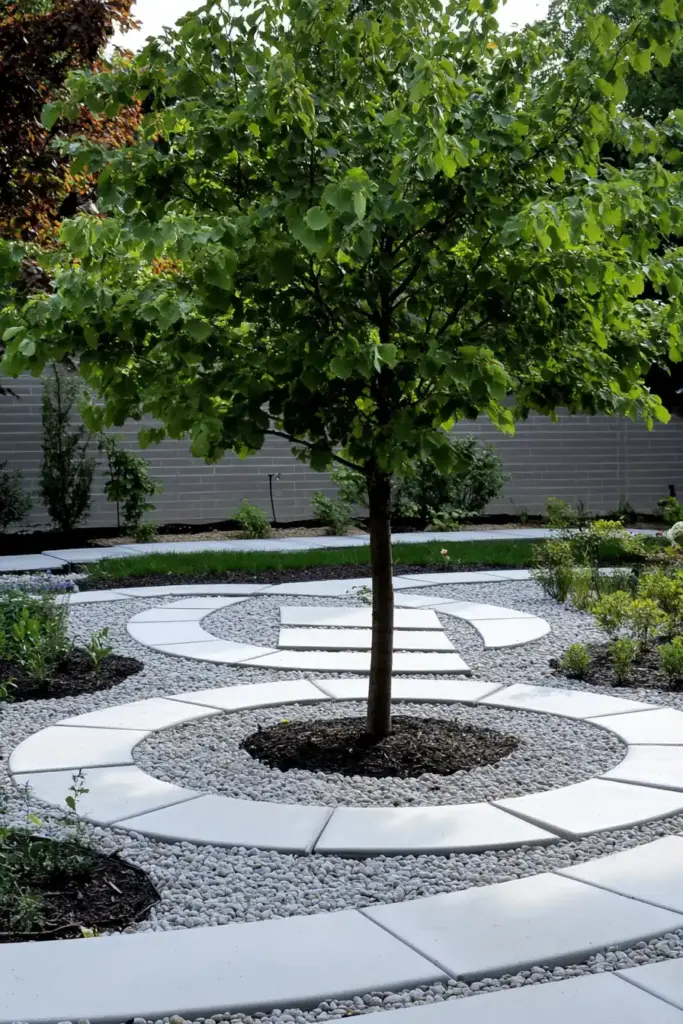
For a modern, minimalist aesthetic, gravel landscaping around trees is both functional and visually striking. It’s especially effective in dry climates or areas where grass is tough to maintain. And when used in front of privacy trees along the fence, it adds contrast and texture that elevate your entire landscape design.
Start by laying a high-quality landscape fabric to suppress weeds and protect the tree roots. Then, cover the area with your choice of gravel—pea gravel, crushed stone, or decorative pebbles all work well. Choose a neutral tone that complements nearby hardscaping and plantings.
To enhance the design, integrate stepping stones or large pavers around the tree to create walkways or access points. Consider adding a few ornamental grasses or succulents in containers for an extra layer of style.
Design Tip: Gravel areas create visual “breathing room” between major features like your tree and a border of privacy trees along the fence, helping the whole garden feel spacious and organized.
5. Paver Ring Pathway
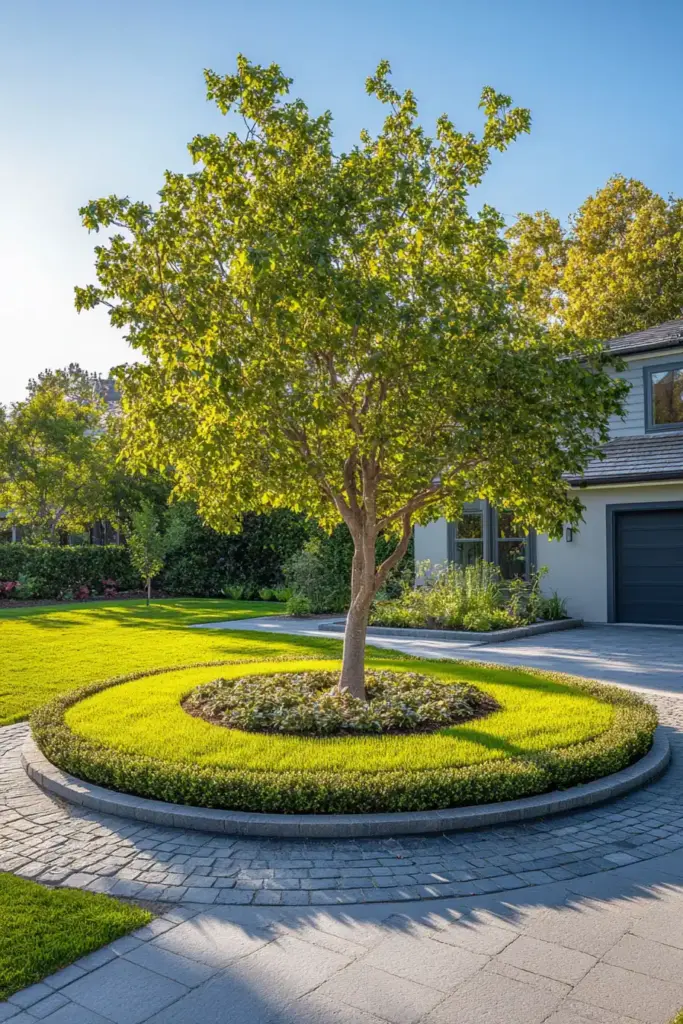
A paver ring pathway is one of the most eye-catching ways to define space around a tree, especially in front yards where curb appeal is key. It creates an intentional, welcoming focal point that also blends well with privacy trees along a fence to add structure and style across your landscape.
To build this feature, lay stone, brick, or concrete pavers in a circular pattern around the tree base. Be sure to space them evenly and allow gaps for planting low-growing ground covers like creeping thyme or sedum between the pavers. This not only softens the hardscaping but introduces color and fragrance.
A paver ring works especially well as a transitional element—guiding visitors from lawn to garden bed, or tree to privacy screen—while protecting delicate roots by discouraging trampling.
Landscaping Bonus: Position your paver ring as a visual anchor that ties into the alignment of privacy trees along your fence, creating harmony and flow throughout the yard.
6. Wildflower Meadow Ring
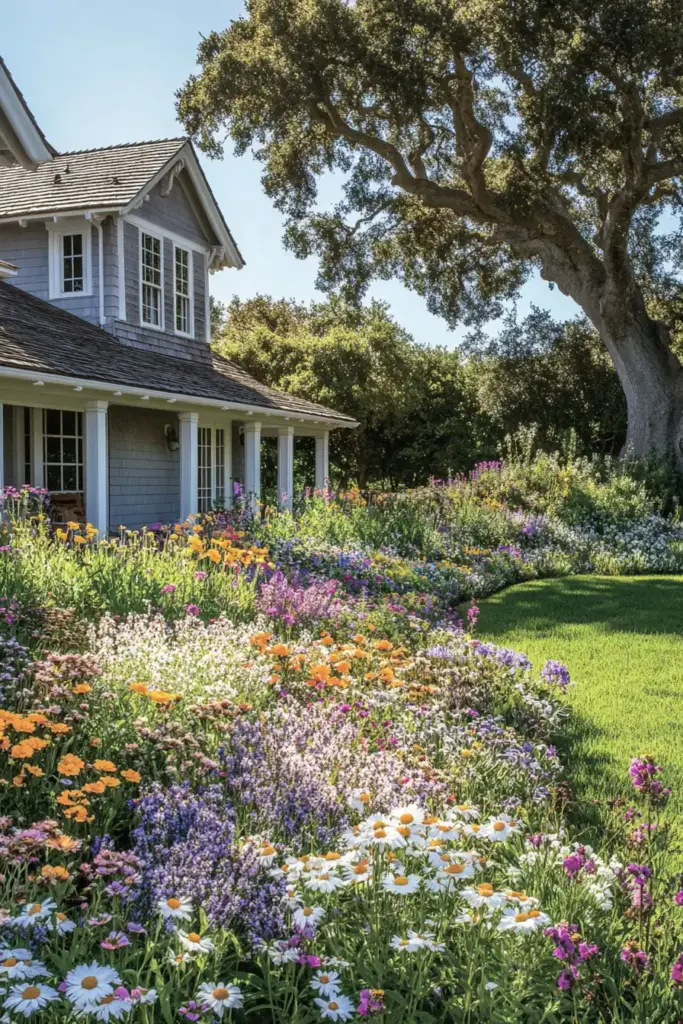
Transform the space under your tree into a burst of seasonal color with a wildflower meadow ring. This approach adds a touch of natural charm and encourages biodiversity—all while complementing your privacy trees along the fence with a softer, wilder aesthetic.
Begin by lightly cultivating the soil around the tree, being careful not to disturb roots. Scatter a mix of wildflower seeds chosen for partial shade—look for varieties like black-eyed Susan, bee balm, columbine, or woodland phlox. Water regularly until established, then let nature take over.
As the flowers bloom and shift with the seasons, the area becomes a dynamic focal point that attracts butterflies, bees, and beneficial insects. It’s a perfect fit for larger yards where you want to maintain a more relaxed, cottage-garden vibe.
Natural Harmony Tip: Pairing a meadow ring with privacy trees along a fence blends formal and informal styles beautifully, offering privacy without losing that wild, inviting garden feel.
7. Tree Bench
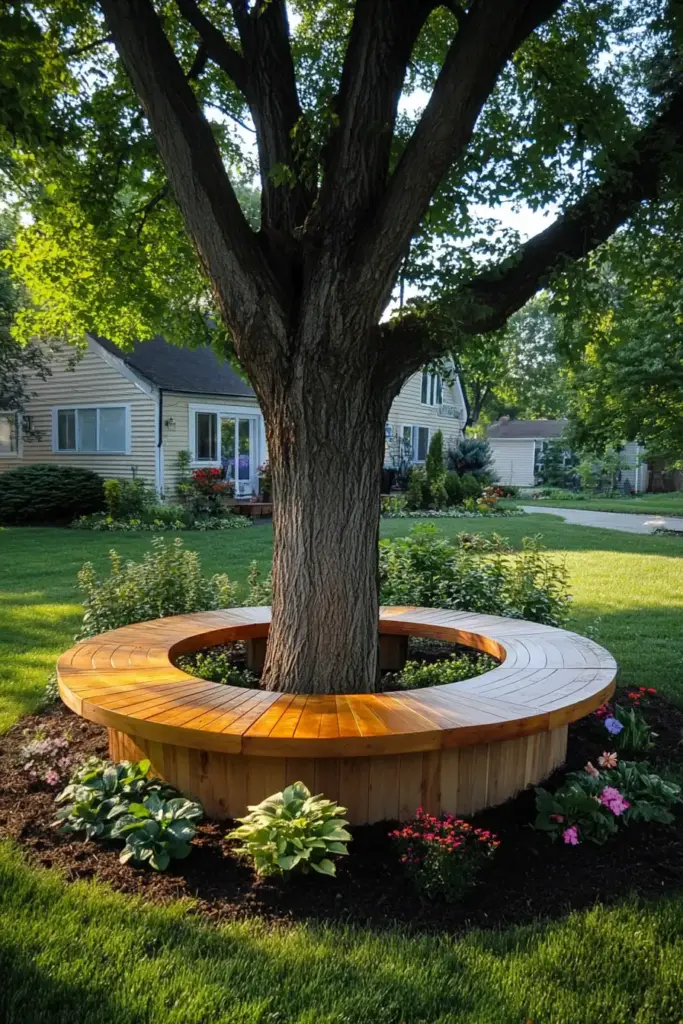
A tree bench is both a functional feature and a charming focal point. Wrapping a circular or semi-circular wooden bench around the base of a mature tree creates a cozy shaded seating area — a perfect place to relax, read, or enjoy your garden. It also complements nearby privacy trees along a fence, encouraging you to use the space, not just view it.
To build one, use pressure-treated wood or weather-resistant composite boards. Make sure the design allows airflow and leaves space around the trunk to avoid damage. For a polished look, stain the wood to match nearby fencing or garden furniture.
This idea shines in family-friendly gardens, offering extra seating without taking up additional lawn space. It also doubles as a visual connector between hardscape and softscape areas in your landscape.
Design Note: A tree bench near a line of privacy trees along the fence creates a peaceful retreat that feels both enclosed and open — perfect for meditative moments or social gatherings.
8. Stacked Rock Beds
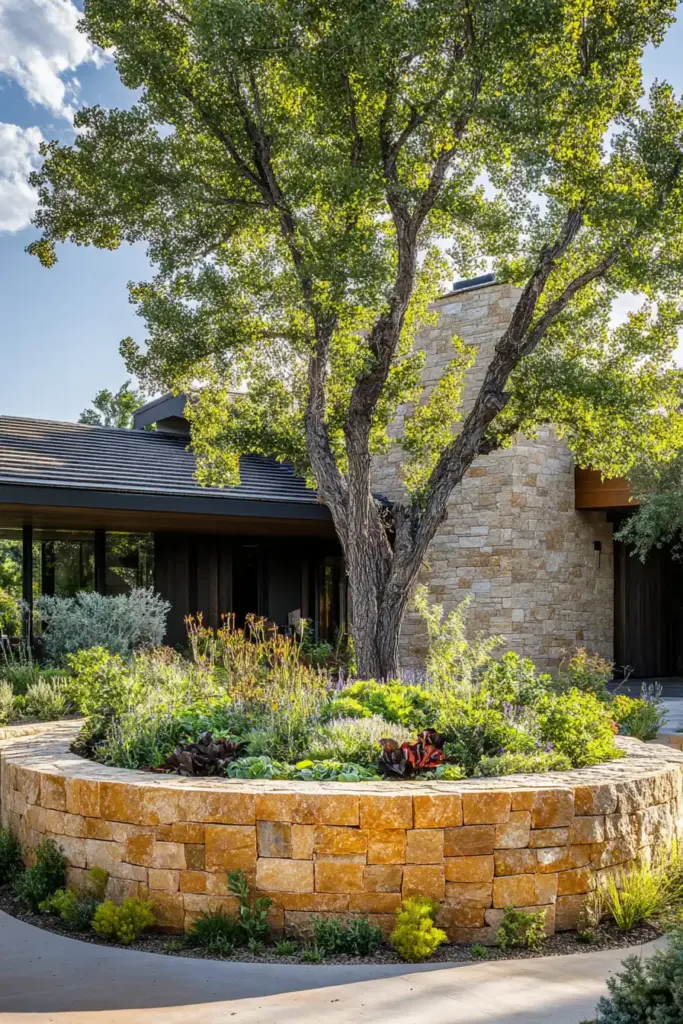
For a rustic, elevated look, stacked rock beds are a beautiful way to create depth and texture around a tree. By stacking flat stones or natural boulders into a low retaining wall, you can form a raised planting bed that draws the eye upward—perfectly complementing privacy trees along a fence that add height and enclosure to your yard.
This approach is ideal on sloped ground or where you want to give the area under a tree more structure. Once the stones are stacked securely, fill the bed with well-draining soil and plant shade-tolerant species like ornamental grasses, creeping phlox, or coral bells.
Not only does this method enhance visual appeal, but it also protects tree roots by keeping foot traffic and soil disruption away from the trunk.
Curb Appeal Tip: Use similar stone types in your stacked bed and fence border to tie in your privacy trees along the fence, creating a unified, harmonious garden palette.
9. Companion Planting Under Fruit Trees
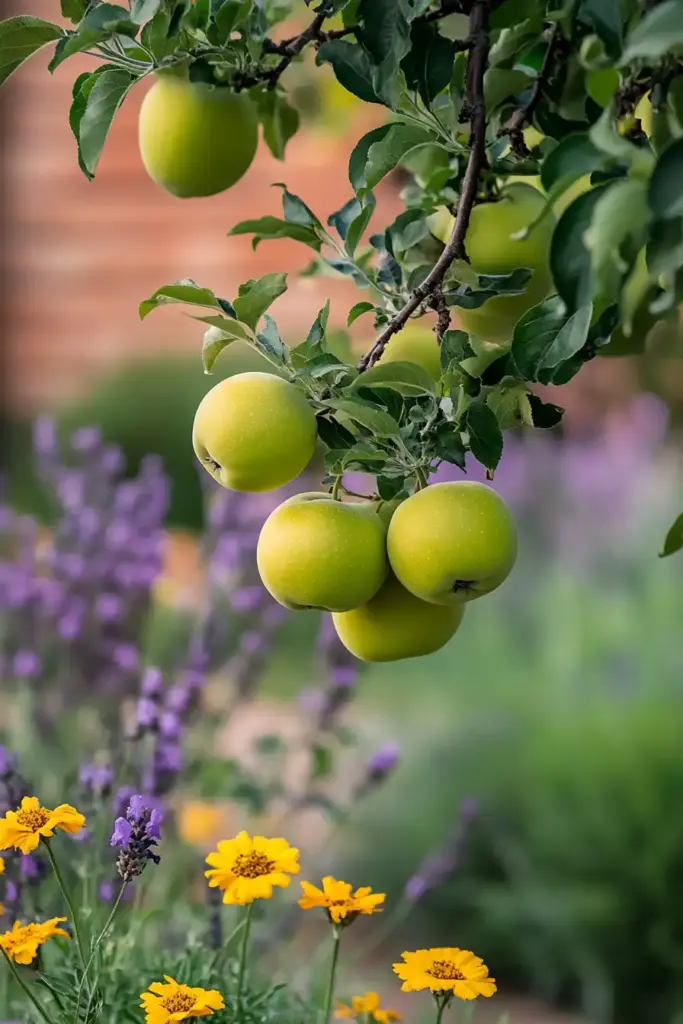
Companion planting beneath fruit trees isn’t just beautiful—it’s smart gardening. This method uses specific plants to attract pollinators, deter pests, and improve soil health, all while making the base of your tree more visually appealing. When paired with privacy trees along a fence, it turns your backyard into a productive and layered edible landscape.
Choose beneficial companions like lavender (repels moths), chives (ward off aphids), and marigolds (protect against nematodes and whiteflies). These plants add color, fragrance, and texture—and their blooms attract bees and butterflies essential for fruit pollination.
You’ll want to plant these companions in shallow soil layers around the drip line of your fruit tree, avoiding heavy digging near the roots. Mulch can be added between plantings to retain moisture and reduce weeds.
Pro Gardening Tip: Combine companion planting with a row of privacy trees along your fence to create a multi-functional garden zone that’s productive, protected, and full of biodiversity.
10. Log Edging
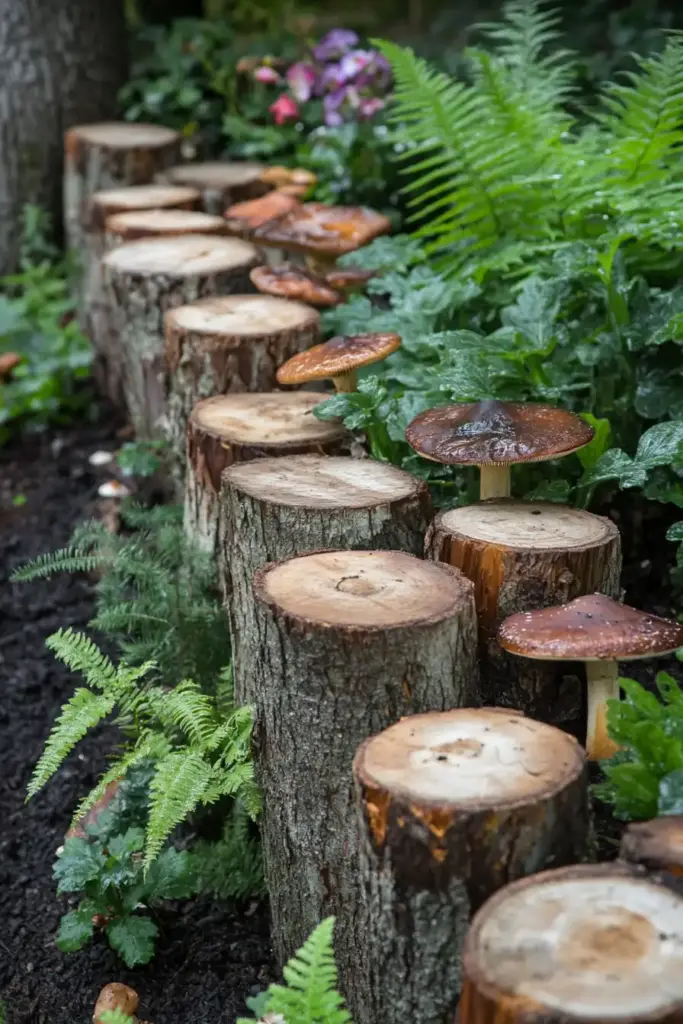
For a cozy, cottage-style garden, log edging is a wonderfully rustic way to frame the space around trees. It adds texture and natural charm—especially effective when your landscape already features privacy trees along a fence, bringing a cohesive woodland vibe to your entire yard.
To create this look, gather small logs, branches, or tree stumps, and cut them into uniform sections. Place them vertically around the base of the tree to form a low border. You can also alternate sizes for a more whimsical, organic feel. Inside the border, add mulch or shade-friendly plants for a tidy yet relaxed aesthetic.
Log edging is especially useful in gardens where you want structure without hard lines. It keeps mulch in place and subtly separates tree zones from lawns or pathways.
Eco-Friendly Idea: Repurpose branches from trimmed privacy trees along the fence for your log edging—a sustainable way to tie every part of your landscape together.
11. Shady Ground Cover
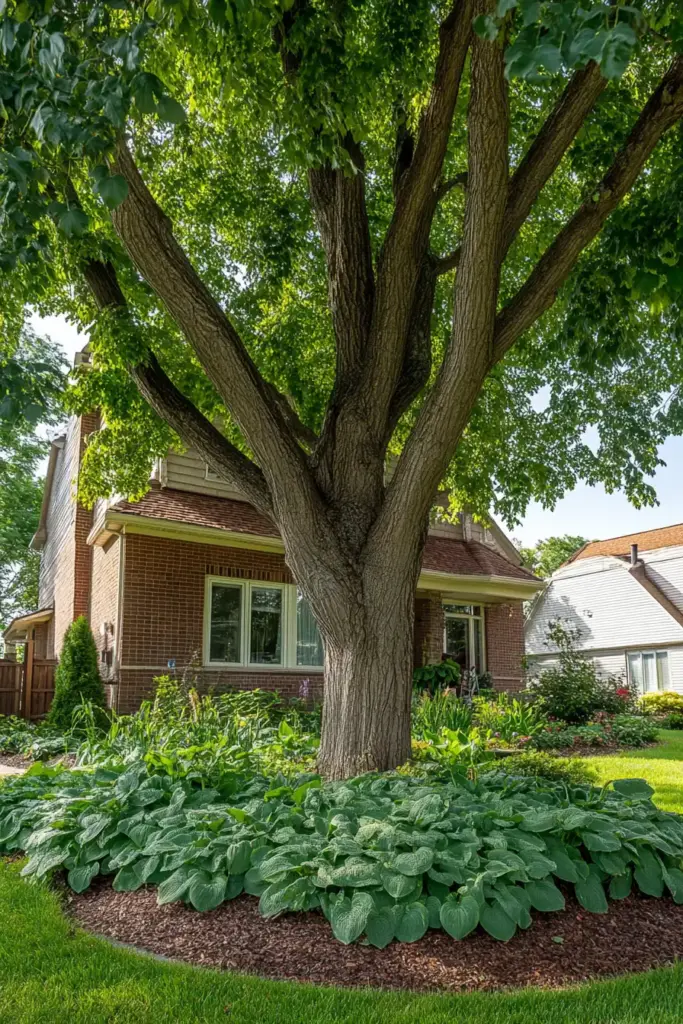
When dense tree canopies block sunlight and grass won’t thrive, shady ground covers come to the rescue. These low-maintenance plants fill the space beneath trees with lush greenery and texture. Plus, they pair effortlessly with privacy trees along a fence, softening hard lines and adding continuity to shaded borders.
Top choices include hostas, ferns, creeping jenny, sweet woodruff, and pachysandra—all of which flourish in low light and help suppress weeds. These plants form a natural carpet that cools the soil, retains moisture, and protects tree roots from erosion.
To establish a ground cover bed, clear the area of weeds, loosen the soil gently with minimal root disturbance, and plant in a staggered pattern for quick fill-in. Mulch lightly between new plants until they spread.
Design Harmony Tip: Ground covers under large trees balance beautifully with vertical privacy trees along your fence, ensuring every layer of your landscape is thriving—even in the shade.
12. Decorative Pebble Mosaic
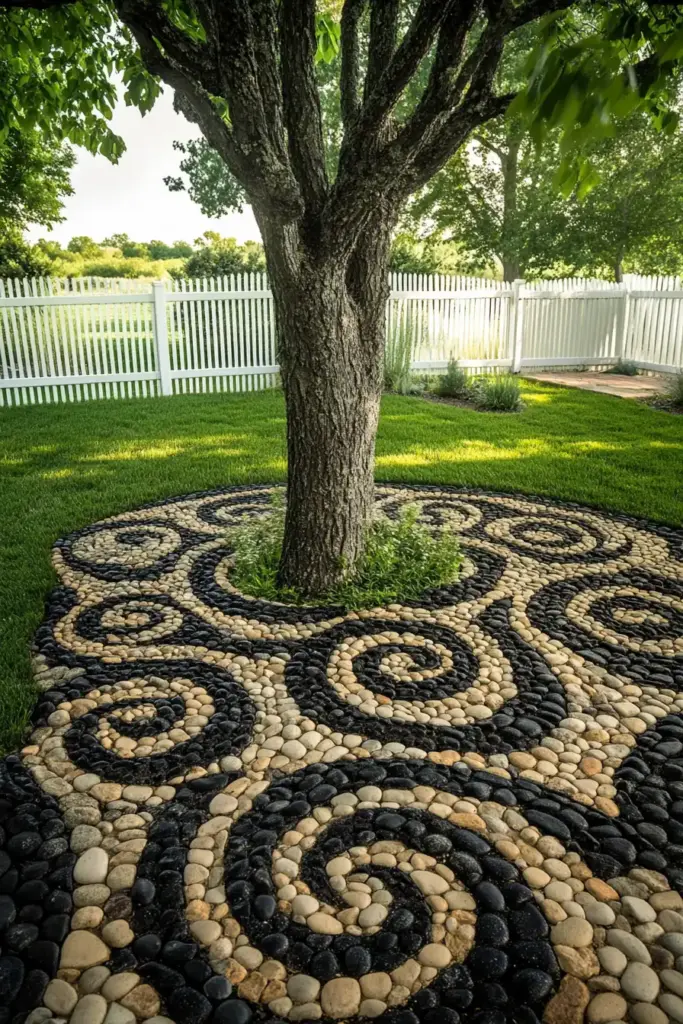
For gardeners who love creativity and detail, a decorative pebble mosaic is a stunning way to landscape around trees. This design transforms plain ground into a work of art using colorful gravel, river stones, and geometric or freeform patterns. It also contrasts beautifully with the natural vertical lines of privacy trees along a fence, adding artistic flair to your yard’s foundation.
Start by outlining your desired design around the tree—spirals, waves, mandalas, or even abstract shapes work well. Then, dig just slightly below the soil surface, lay down a weed barrier, and carefully place different shades and sizes of pebbles to fill in your pattern. Larger stones can outline edges or serve as accents.
This idea is perfect for focal trees in highly visible areas, and because it doesn’t involve planting or watering, it’s ultra-low-maintenance.
Pro Styling Tip: Echo colors from your pebble mosaic in nearby planters or mulch around privacy trees along your fence to create a cohesive, curated landscape theme.
13. Evergreen Shrub Border
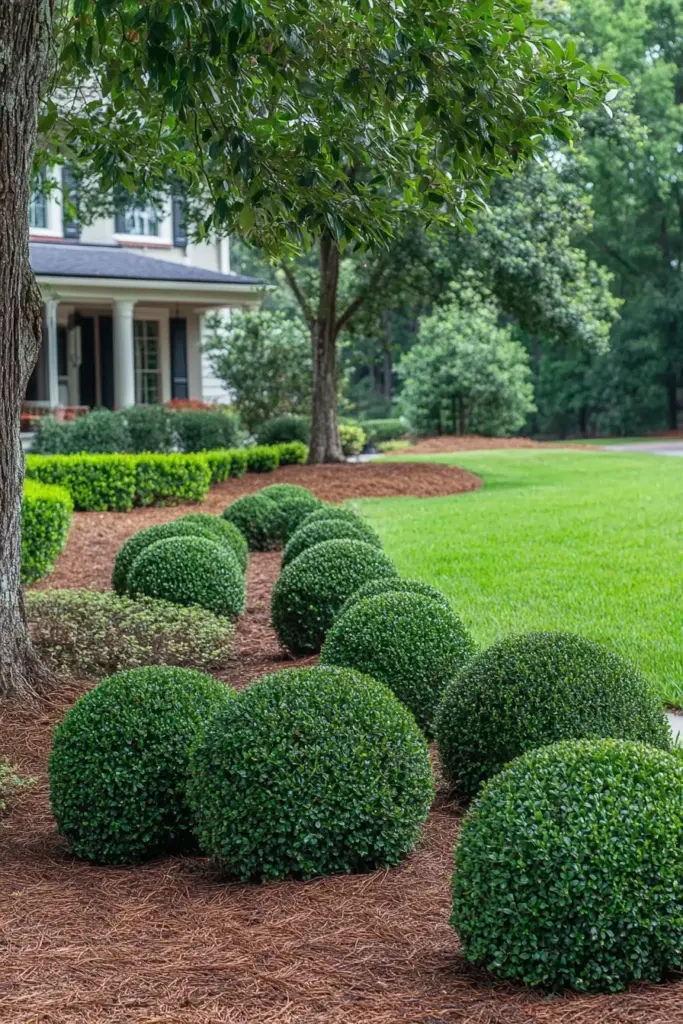
For year-round structure and a refined, polished look, few options are as effective as an evergreen shrub border around trees. These low-maintenance shrubs add shape and color throughout every season and align beautifully with privacy trees along a fence, reinforcing a clean, intentional landscape layout.
Consider compact varieties like boxwoods, dwarf hollies, or Japanese yews. Space them evenly around the base of the tree, allowing room for growth without crowding the trunk. Underplant with low-profile perennials or mulch to finish the look.
This style is especially fitting for front yards or formal garden designs where symmetry and order matter. Plus, evergreen shrubs help visually anchor the tree within the broader garden framework, making it feel like a deliberate design feature—not just a planted leftover.
Design Continuity Tip: Use the same or similar evergreen shrubs in both your tree border and along the line of privacy trees along your fence to create a seamless, repeating pattern throughout your landscape.
14. Fairy Garden Base

If you’re looking to add a bit of whimsy and wonder to your yard, a fairy garden base around a tree is a delightful choice—especially charming near children’s play areas or visible from patios and pathways. When positioned near privacy trees along a fence, this mini landscape feels like a hidden woodland world just waiting to be discovered.
To create one, choose a small- to medium-sized tree with a low, open base. Add miniature garden accessories such as fairy doors, tiny benches, stepping stones, and small figurines. Incorporate low-growing plants like moss, baby tears, or miniature ferns to build a soft, enchanted feel.
Layer the area with bark mulch or pebbles, and consider placing twinkle lights in the branches above for magical nighttime ambiance. It’s a simple yet creative way to engage the imagination—both yours and your guests’.
Whimsical Landscaping Tip: A fairy garden surrounded by tall privacy trees along a fence feels more secluded and magical, turning your garden into a truly storybook setting.
15. Multi-Tree Landscape Bed
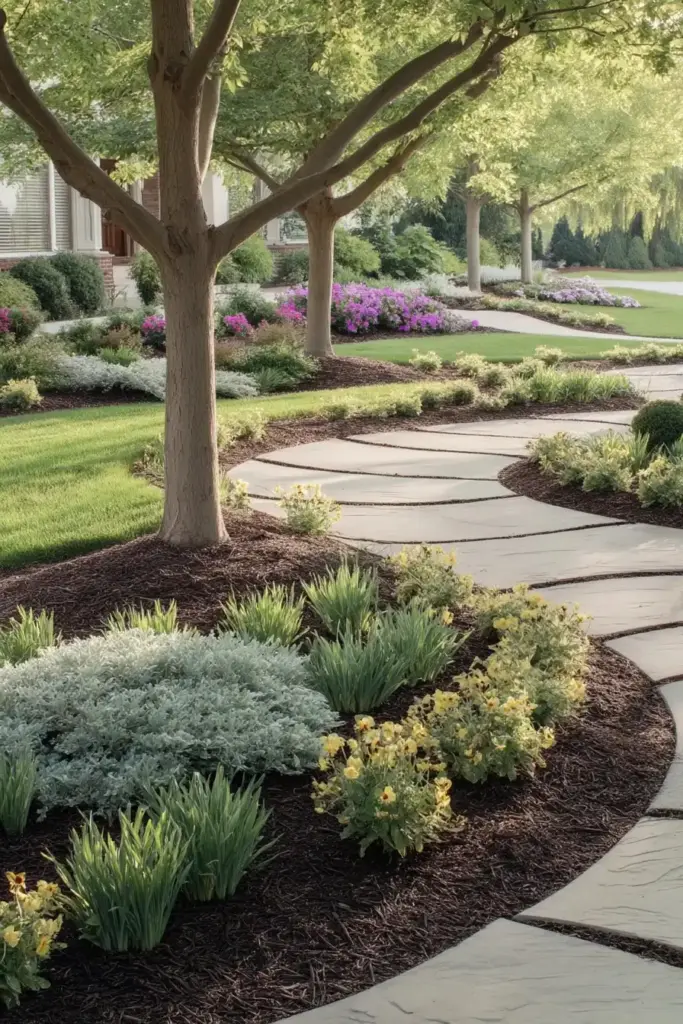
If your yard features several trees in close proximity, a multi-tree landscape bed is an excellent way to unify the space. Instead of treating each tree as a separate design challenge, this approach connects them into one continuous garden feature—especially effective when aligned with privacy trees along a fence, forming a seamless, layered backdrop.
To build this design, create a large, flowing bed that links multiple trunks with mulch, stepping stones, and low-maintenance plants. Use shade-tolerant ground covers or ornamental grasses to fill gaps, and add accents like large stones or rustic benches to create visual interest.
This method not only simplifies maintenance—by eliminating hard-to-mow patches—but also brings balance and cohesion to your garden. It’s ideal for backyards where trees form a natural canopy or border.
Design Integration Tip: Extend the bed to meet the base of your privacy trees along the fence so the entire tree line reads as one harmonious and intentional landscape zone.
Frequently Asked Questions
❓ What are the best privacy trees to plant along a fence?
The best privacy trees along a fence include fast-growing evergreens like Leyland cypress, Thuja Green Giant, and Eastern red cedar. These varieties offer dense, year-round foliage and grow tall enough to block out unwanted views. For a curated list with planting tips, explore our post on beautiful plants for fence line privacy.
❓ Can I landscape around trees without damaging the roots?
Absolutely. Use shallow-rooted plants, mulch, or gravel rather than digging deeply near the trunk. Raised beds, rock landscaping ideas, and natural edging are great ways to enhance the space while preserving root health. Avoid piling mulch against the bark to prevent rot.
❓ How do I combine privacy trees with other landscaping features?
Blend privacy trees along a fence with layered garden elements like tree rings, decorative borders, and walkways. For inspiration, explore budget-friendly landscaping ideas and DIY trellis decorations that add both charm and depth to your layout.
❓ What ground cover grows best under trees?
Shade-loving ground covers like hostas, ferns, creeping jenny, and pachysandra thrive beneath trees where grass often struggles. For pathways or larger shaded zones, explore our guide on walkable ground cover garden paths for more low-maintenance ideas.
❓ How far from the fence should I plant privacy trees?
Generally, it’s best to plant privacy trees 3 to 8 feet away from the fence, depending on the species’ mature spread. This spacing ensures healthy growth and airflow. For detailed spacing recommendations and layout ideas, visit our guide on fast-growing privacy trees.
Conclusion
Landscaping around trees isn’t just about filling gaps—it’s a chance to celebrate your garden’s natural structure, support healthy growth, and inject character into your outdoor space. Whether you’re designing a cozy seating nook under the branches, planting a colorful wildflower garden, or installing a minimalist pebble-based design, each idea complements your tree’s natural presence while boosting your yard’s overall aesthetic.
Best of all, incorporating these features alongside fast-growing privacy trees along your fence ties your landscape together into a peaceful, layered sanctuary. With the right inspiration and a little planning, even the most root-filled, shaded spaces can become beautiful and functional highlights of your yard—spaces that boost both beauty and curb appeal.

